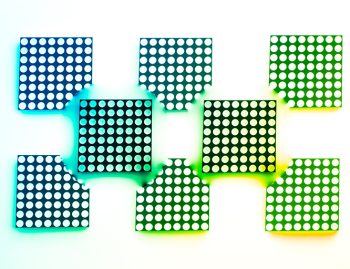
Is your product user-friendly? From communications to healthcare and the Internet of Things, LEDs play a vital role in cementing a yes or no decision. An unwanted glow, murky coloration, or stray light leak can lead to mixed signals and false readings.
When two LEDs of different colors blend together, the effect is called crosstalk. This can make or break your product design: competing indicator lights both illuminate, or multiple colors mix into an unwanted message.
Why leak-free LEDs are so important to an effective user experience
As of today, consumers cannot read the minds of the electronics they interact with. LEDs help build this bridge, providing important information that drives the overall product experience.
You can find LEDs responsible for:
- Indicators: These LEDs communicate a status, signal an alert, or share the product’s current mode. Consider the charging box for a health monitor wearable shining a green light for “fully charged,” or a WiFi router that displays white when an internet connection is live.
- Functional: An LED-lit meter can announce activity progress. Think of an industrial device that’s charging or connecting.
- Sensors: LEDs play an essential role in the smart home. Proximity sensors light up in the presence or absence of another device—like an alarm sensor that knows if a window is open or closed.
- Design: This type of LED provides a touch of fashion over function. In this application, LEDs illuminate a logo or other decorative element.
Poor illumination in these areas is more than a minor frustration for users. False readings can completely upend your Human Machine Interface, dismantling the intended use of your product.
LED design tips for eliminating light bleed
Here’s what you need to consider to make sure your LEDs illuminate brightly and precisely on target.
Explore adapters like ZeroLightBleed™
Light can slip through gaps and openings, reducing the targeted amount of light that can reach its destination. One method for channeling light directly to the lens without loss is a ZeroLightBleed™ adapter.
ZeroLightBleed™ puts a stop to light leaks at the source. Solder this special housing directly to the PCB to eliminate light leakage. The light pipe, LED, and adapter comes as a single piece, eliminating the need for customizations.
Determine the viewing angle
How you control the photons that an LED emits is an important characteristic of a user-friendly product. You want to direct as much output toward the illumination target as possible.
Here’s where you need to think about how users will need to view the LED.
- Side view: For these applications, a broader viewing angle is best. This will provide the most uniform light for customers needing to read LED status from the side.
- Front view: Go with a narrow viewing angle such as 30° for products users will need to check from the front. This design maximizes brightness.
LED viewing angles can span 30° to 130°. Understanding how the user will ultimately interact with your product can help you pick the best one.
Understand how light travels to the point of use
Light pipes come in two common designs: flexible and rigid. Amongst their distinct qualities, they each specialize in moving light over a specific distance. You can solve the issue of light leaking around the circuit board by pairing either system with a ZeroLightBleed™ adapter.
A rigid light pipe is your best selection if the ultimate display sits close to the circuit board. This type of light pipe is a pro at moving light over very short distances up to 3 inches.
Opt for a flexible light pipe if you need to move light further from the source or around any bends or curves. They can transmit clear, uninterrupted light up to 330 feet.
Maximizing the amount of light that makes it from source to destination is a critical component of your human-machine interface—and ultimately, your overall user experience. By closely considering how the end-user will interact with your product, you can make the right design decisions to eliminate false LED readings and muted colors.
Leave a Reply Cancel reply
You must be logged in to post a comment.









